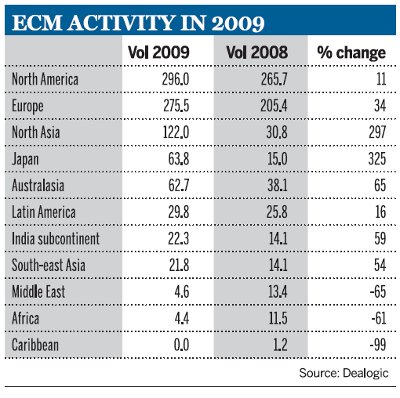In the dark days at the start of the 2009, few expected financial markets to recover as they did. Even fewer expected records to be broken. They were. Writer Geraldine Lambe
Despite beginning the year with the lowest quarterly volume since 2003, equity capital markets (ECM) saw a 42% pick-up on 2008 - to $903bn - and ended 2009 on a high, with record fourth-quarter issuance of $324.8bn. This was good news for banks, with global ECM revenue in 2009 rising 66% to $23.6bn from $14.2bn in 2008.
Japan saw the most staggering rise, with an increase of 325% over 2008. But in a theme reflected in economic figures worldwide, the BRIC (Brazil, Russia, India and China) economies saw some of the most impressive volumes, with total issuance rising by 64% to $138.1bn: Chinese ECM rose by 97%; India by 61%; and Brazil by 20%. Only Russia saw a decline, falling by 35% on 2008 volume.
Maturing debt
Such figures were not surprising considering the amount of debt that was due to mature in 2009. Peter Guenthardt, head of ECM, EMEA, at UBS, says that in October 2008 the bank identified €1300bn of non-financial corporate debt in Europe alone due to be refinanced last year - similar to the amount that was absorbed in the bull markets of 2000 and 2003.
"It was clear that with banks trying to shrink their balance sheets, a large proportion of this would be unable to be refinanced or rolled over. Therefore it would have to be replaced with equity and it was obvious that there would have to be significant equity capital raised last year," says Mr Guenthardt.
In Europe - where many corporates have traditionally seen the issuance of additional equity as a sign of failure and avoided it at all costs - some were forced to come to market to delever balance sheets. "Many conservative corporate executives have historically found the notion of issuing equity an alien concept; but they have been forced to issue equity out of necessity," says Rupert Hume-Kendall, president of equity capital markets at Bank of America Merrill Lynch.
Most market participants expect last year's robust growth to continue in 2010, driven by further re-equitisation by both banks and non-financials, private equity exits, continued emerging markets issuance, privatisations and a larger equity component in M&A financing. It should also be a good year for convertibles - where a combination of reasonable asset valuation levels and a still benign interest rate environment look set to underpin issuance.
IPO market to return
The number one theme for the year, says Alasdair Warren, head of European ECM at Goldman Sachs, will be the return of the initial public offering (IPO) market. "It reopened in Q4 last year, and in Q1 this year we are already expecting $20bn to $30bn of IPOs. The first part of the year is likely to be dominated by financial sponsors exiting their portfolio companies, but this year will probably also see a lot of corporates raising capital via the IPO of subsidiary companies," he says.
Investors' growing risk appetite will also drive further emerging market activity. "As long as risk appetite remains stable, it will help to drive emerging market equity issuance," says Nick Williams, head of EMEA ECM at Credit Suisse. "Our deal pipeline has IPOs coming from Africa, Russia, Poland and the Czech Republic. There are also opportunities in Latin America, Asia and the Middle East."
Prudence remains key
Although markets have recovered from their near death experience, the watchword is still prudence.
"Disciplined treasury management will underpin corporate activity this year," says Paul Staples, head of corporate finance at BNP Paribas. "We are still in a relatively sober world, where issuers care about their ratings. While credit market conditions appear robust, there are concerns about the exit from quantitative easing and the effects of sovereign debt. We expect clients to err on the side of prudence - and that means further de-leveraging and seeking to access the equity markets for event-driven financing."
Viswas Raghavan, head of international capital markets at JPMorgan, agrees that the prevailing mood of caution will help to drive further equity activity. "The crisis showed us that liquidity problems can quickly turn into capital problems. This means that corporates are most likely to do more to build their equity capital in the coming year."
With cash levels high and inflation not yet a significant factor, investors will likely continue to weight out of cash and into higher yielding assets - which bodes well for equity markets. But there could be a few curve balls. There is still a chance that economic recovery stalls, particularly if governments mistime the exit from quantitative easing. Moreover, it is unclear how much the return of risk appetite is based on fundamentals rather than on technicals. How strong are banks and corporate order books?
Only when the answers to these questions are positive will the recovery look sustainable.



